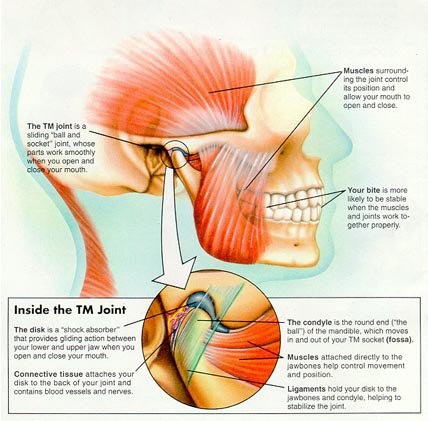TMJ/TMD

Approximately one in eight people suffer from some type of jaw joint problem. The common symptoms may occur singularly or in various combinations. Below are some of the symptoms of a TMJ Disorder. If any of these apply to you or someone you know, contact us right away for an appointment.
- Headaches and/or facial pain of varying intensity
- Teeth that do not meet properly when you bite down
- Jaw moves to one side when opening mouth
- Pain or difficulty chewing
- Ear stuffiness
- Pain or pressure behind the eyes
- Limited opening or “locking” of jaw and mouth during normal movements
- Jaw clicking or popping
- Jaw pain
- Difficulty swallowing
- Pain of various intensity around one or both ears, or temple area
- Dizziness or ringing in the ears
- Neck and/or shoulder pain
Causes of TMJ Dysfunction
Research has shown that usually more than one factor is responsible for TMJ Dysfunction. This problem may occur by itself or be part of a complex problem:
- Trauma (automobile accident or sports injury)
- Improper occlusion (bite)
- Jaw clenching and tooth grinding
- Psychological factors including stress and anxiety
- Osteoarthritis (degenerative)
- Inflammation of the joint
- Nervous habits
Treatments
Initially, a new patient is scheduled for a thorough evaluation of their concerns. This examination and consultation takes into account the onset, duration, intensity of pain in the affected areas, and other pertinent information. The goal is to identify your specific problems, causes, and possible solution. Further diagnostic testing may be involved. We provide state-of-the-art technology for the diagnosis and treatment of TMJ. Our practice philosophy is a conservative, non-surgical approach to treatment.
Once a diagnosis of your condition has been made, and a treatment plan established, your treatment may include any or all of the following:
- Physical therapy to reduce muscle spasms
- An extremely comfortable, easy-to-wear, aesthetic, dental orthotic splint made by us. The orthotic covers the lower teeth, holding the jaw in proper alignment, which reduces tension in the jaw joint and allows proper healing to take place.
- Mild medications, if necessary
Recommended treatment is always subject to changes or modifications once treatment has commenced. Everyone has a different healing response. The success of your treatment is highly dependent upon good patient cooperation.
If you have experienced a whiplash injury or any type of head trauma, you should know that 85% of these types of accident victims demonstrate TMJ symptoms. Many times this condition is overlooked immediately after an accident. Symptoms like head, neck, and facial pain can occur as long as two years after the initial accident or injury. It is imperative that these types of injuries are treated as soon as possible so the condition does not deteriorate.
*Not every individual can experience complete recovery from their problems, but most everyone can expect significant improvement and a better quality of life.


